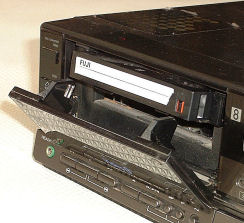 | |
 | |
 | |
 | |
 | ||||||
| ||||||
 |  | |||||
 | FORMAT: Video 8 | |||||
DATE: 1985 PRICE: £? [2005: £?] 36x33x9cm 7.3 kg | ||||||
 |  |
|
| ||||||||||||||||||||||||||||||
| Video8 and it's high-band offspring Hi8 are best known as camcorder formats, but there have been a few VCRs produced as well. The EV-S700 was Sony's first Video 8 VCR. | |
| As far as video is concerned, it's a fairly normal twin-speed deck, with just a couple of special features: double-speed playback, and a handy "rewind then play" function. Physically, apart from it's small size, the only unusual feature is the semi tray-style tape loading mechanism (which was presumably derived from camcorder mechanisms).The door opens like a cassette deck, but the tape is "posted" like a front-loader, and then drawn into the machine like a CD tray. |  |
| But it's audio where the EV-S700 really shines. As well as PCM digital stereo sound, which can be post-dubbed and mixed, the machine can handle bilingual recordings, FM simulcasting, and in audio-only mode can record a staggering 24 hours of digital audio on a single cassette. | |
| In fact, the machine is described by Sony as a "Digital Audio Video recorder", and they clearly expected some peopleto use it more for audio than video. |
 The audio controls, behind the flap. All older Sony's suffer from "broke flap hinge", but the 700 uses a magnetic catch and clip-on hinges - they must have been listening to their customers! |
| The EV-S700 could record simulcasts, where high-quality stereo sound was broadcast over FM radio at the same time as the TV broadcast (NICAM digital stereo sound wasn't available until 1986). Or, the machine could record six four-hourtracks along the length of the tape (no pictures) to give a total recording time of 24 hours, though Video 8's slow rewind - 3 minutes to return to the beginning - meant that continuous recording was impractical. |
| CD's were only just arriving in 1985, so it was perfectly possible that a tape-based audio format would succeed first - particularly one that could record. At least, that was Sony's idea, though the SL-C9 and SL-F1 could be used (with an external encoder) as pure-audio PCM recorders since the beginning of the 1980's, and they hadn't exactly set the world alight, as audio machines. One problem was that the audio response, 20Hz to 15KHz, wasn't quite high enough to be considered true HiFi by the hardcore audiophiles - 20KHz was the usual requirement. Normal users wouldn't be able to hear the difference, but of course normal users wouldn't be buying a PCM digital audio recorder. As it happens this wasn't really relevant, however, because Video 8 never caught the public imagination as a home VCR format, despite its undeniable success as a camcorder system. |